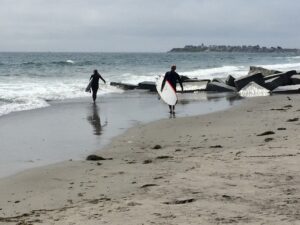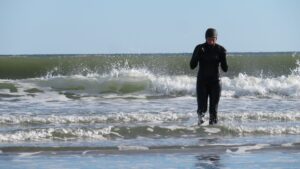Kate Burgess is a Salazar Center partner and serves as NCEL’s Conservation Program Manager, where she enjoys collaborating with legislators on a variety of land, water, wildlife, and human issues.
My dad and I spend a lot of time surfing. We mostly go in the winter, not because we’re gluttons for punishment, but because that’s when the swell is allegedly the best on this side of the Atlantic. With our 7 mm wetsuits, booties, mittens, and hoods, we’ve adopted the proxy skin of seals, reminded only of the season when the sea is dusted with snow, or when an icy wave humbles the exposed skin on our face, leaving eyes stinging and heart pumping.

But recently, things have changed. The water in the winter isn’t as cold as it used to be. Last December, I didn’t need my mittens or booties. In the summer, I stopped wearing a wetsuit altogether, worried I’d overheat in the near-bath temperature waters of Nahant Beach that used to induce a sharp inhalation at the dip of a toe.
Given these obvious impacts of climate change, my dad and I have been thinking about another way to spend our time in the sea: ocean farming. With the dramatic warming of our ocean, we’re wondering what we can do to intervene, and regenerative ocean farming – particularly kelp cultivation – is one nature-based solution with lots of promise.
 Kelp acts as a highly effective carbon sink, a natural defense against storms, habitat for species, and can be harvested for animal feed, medicine and actually, a pretty decent beer. It addresses the twin climate and biodiversity crises concomitantly, since they are inextricably linked and need to be addressed as such.
Kelp acts as a highly effective carbon sink, a natural defense against storms, habitat for species, and can be harvested for animal feed, medicine and actually, a pretty decent beer. It addresses the twin climate and biodiversity crises concomitantly, since they are inextricably linked and need to be addressed as such.
Nature based solutions (NBS) like planting kelp are a means of leveraging the innate power and potential in earth’s systems, flora and fauna, and using them to promote resilience. Many of these solutions – including, for example, prescribed burns and oyster reef restoration – have been developed and practiced by Indigenous communities since time immemorial. Without proper recognition, consent for use of knowledge, compensation, and centralization of Indigenous leadership, nature based solutions can become anti-Indigenous, and an extension of the violent and racist colonialism that has and continues to persist in the environmental movement and beyond. Thoughtful consideration of the use of NBS is vital.
These solutions are gaining momentum among communities, practitioners, decision makers, academics, and beyond, and I believe wholeheartedly that they’re one of the best means of making any real dent in recovering species and regulating our climate.
One way that I’m seeing NBS rise is at the state level. My job as Conservation Program Manager with the National Caucus of Environmental Legislators (NCEL) is to track land, water, and wildlife policies, share lessons learned with legislators across the U.S., and help them utilize the best available science and knowledge systems to advance equitable environmental policies. In 2023 alone, hundreds of state bills including NBS were introduced as a means of utilizing nature’s strengths as a solution to climate change and biodiversity loss.
State legislatures are essentially policy ‘test kitchens,’ except with less salt and no Guy Fieri. They’re where innovative measures can be piloted and repeated in other states, and ultimately with enough traction, at the federal and even international levels. States can set, maintain, and/or dismantle important legal narratives – especially when it comes to environmental issues.
For example, Montana’s recent Supreme Court win for youth was largely the result of a rights-to-nature state policy called the “Green Amendment” that was enacted in 1970. Green Amendments are environmental justice tools that solidify our rights to clean air, water, and a healthy environment, putting them on par with our other fundamental civil liberties like free speech. A powerful means of securing health for present and future generations, Green Amendments are picking up speed; in 2023, 13 states introduced Green Amendments, and New York became the first state to enact one since 1971.
With the recent Sackett SCOTUS decision gutting the Clean Water Act, experts say it’s up to states to “step in and fill the void.” With federal protection absent, states are tasked with playing defense for wetlands protection, a habitat coined “earth’s kidneys,” due to their tremendous capacity to filter toxins and sustain life for countless species.
The potential of and pressure on States to play environmental offense and defense is high, but rarely is their capacity. Some, like New Mexico, Vermont, and Nevada (among others) are citizen legislatures, which means lawmakers have full-time year-round jobs on top of being a legislator, and many lack staff, compensation, or even a physical office. U.S. territories lack voting representatives in Congress, so what happens at the state/territory level matters immensely when federal representation is lacking.
States are also treaty partners and have a unique government-to-government relationship with and responsibility to honor the sovereignty of Tribal Nations. Efforts like returning land back, supporting the rematriation of climate keystone wildlife like buffalo, and designing policies that require Free, Prior, and Informed Consent are essential in conjunction with designing state NBS. Indigenous communities are the original stewards of what is now known as the United States, and both traditional and contemporary ecological knowledge are some of the strongest tools available when it comes to bringing flora and fauna back, and regulating our climate – as long as that knowledge is respected and compensated.
Ultimately, my colleagues and I at NCEL try to fill in where capacity is lacking in state legislatures, calling ourselves “remote environmental staff.” We have a 30,000’ view of what’s happening on environmental state policy level on issues relating to, and are at the ready to provide research, briefings, connections to other states and best available science and knowledge systems, anything to help make their jobs easier. Federal efforts like the Bipartisan Infrastructure Law, Inflation Reduction Act, and the Nature-Based Solutions Roadmap have helped make clear the trend towards prioritizing NBS and the onus on States and partners for implementation.
As state trends on nature based solutions continue to rise, we’ll continue to equip lawmakers with the best available science and knowledge/thinking as a means of addressing the twin crises of climate change and biodiversity loss. My dad and I are grateful for nature’s potential to heal, and we’ll join you in doing all we can to help sustain its gifts for future generations of surfers and beyond.

The Salazar Center is hosted the fifth annual International Symposium on Conservation Impact on October 11-12 in Denver, Colorado. The agenda focused on nature-positive solutions and how they can catapult our communities towards durable, high-impact outcomes for climate, biodiversity, and human well-being.

